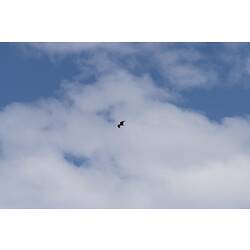General Description
Body light brown, paler and streaked underneath, wings sandy-brown. Has a distinctive pale 'M' shape on the underwings in flight. Tail long with a rounded tip. Body up to 60 cm long. Wingspan 120-145 cm. Females are larger than males. Whistling Kites have a distinctive call, a rapid ascending whistle.
Biology
Whistling Kites usually live near swamps and rivers. They are usually found alone or in pairs. They hunt small live prey including insects, fish, birds and mammals, by swooping while soaring. They will steal prey from other waterbirds and scavenge on carrion, particularly in winter. Whistling Kites maintain and defend territories, and pairs usually remain together for life. Nests are built from sticks and are located in tall trees. Nests can be reused, growing larger each year. They can breed up to three times a year, producing two to three eggs per clutch. Males may help with incubation. Fledglings stay with parents for six to eight weeks. Whistling Kites are often seen soaring high above water or farmland.
Distribution
New Guinea and New Caledonia. Mainland Australia and Tasmania.
Habitat
Lowlands, open pastures and grasslands.
More Information
-
Animal Type
-
Animal SubType
-
Brief Id
A medium-sized bird of prey with light brown body and rounded tail.
-
Colours
Brown
-
Maximum Size
60 cm
-
Habitats
-
Diet
Carnivore
-
Endemicity
-
Commercial
No
-
Conservation Statuses
CITES: Trade restrictions (Appendix II), FFG Threatened List: Not listed, EPBC Act 1999: Not listed, IUCN Red List: Least Concern
-
Taxon Name
-
Common Name
Whistling Kite
-
Kingdom
-
Phylum
-
Subphylum
-
Class
-
Order
-
Family
-
Genus
-
Species Name
sphenurus









